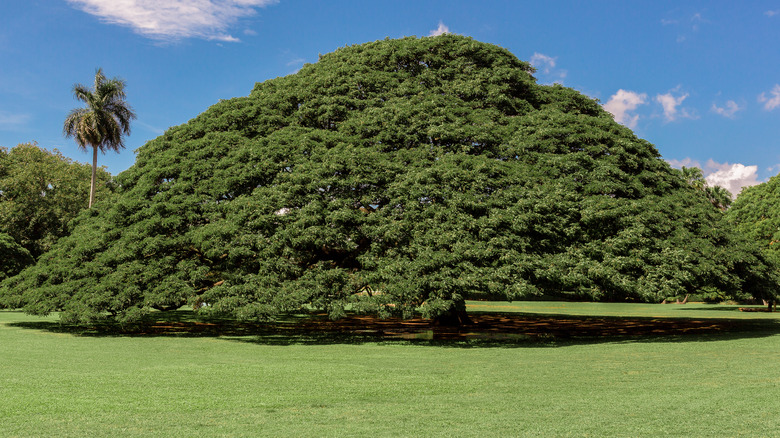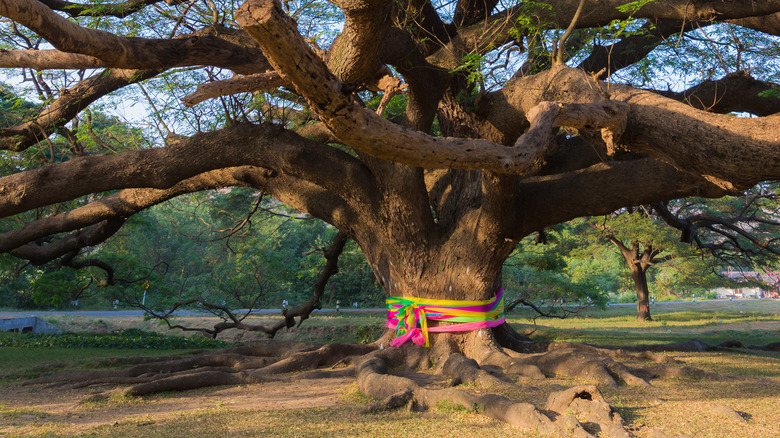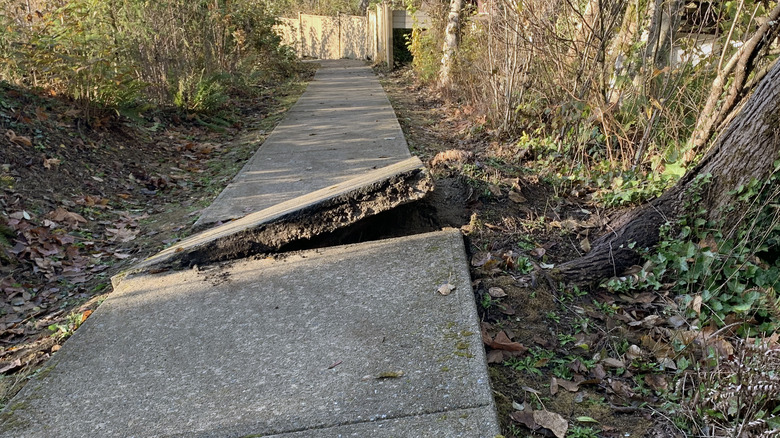The Major Downside Of A Monkeypod Tree You Should Know About Before Planting
A neotropical native, the monkeypod trees (Albizia/Pithecellobium saman) have naturalized in several US territories, particularly Hawaii — the home to the iconic Hitachi tree. Granted, they're tall, gaining between 50 and 80 feet height. What you truly need to know about monkeypod trees is that their elegant, umbrella-shaped, expansive canopies can span over 50 to 100 feet wide, providing ample shade wherever they're planted. Wide canopies require colossal space, making them a poor landscape planting choice. What's more, they grow sturdy surface roots that don't shy away from taking over and damaging your gardens, walkways, and even roads.
These semi-deciduous trees are mostly grown at least 30 feet away from homes and other sturdy structures to give them enough room to grow. Small garden owners have to discard the idea of cultivating them, or their homes are sure to suffer enormous foundational and plumbing damage. Not to mention, the tree roots can possibly uproot garden sidewalks and driveways, creating a trip hazard.
Monkeypod's root system harms lawns
The saman tree develops an extensive root system, especially in soils high in clay or rocks. Since they remain shallow, particularly in wet climates, their spreading becomes a cause for concern. As the tree matures, it competes with the understory vegetation and the surrounding flora for resources like water and nutrients, inhibiting its growth. Its voracious surface roots also make it a poor companion plant unless pruned dramatically to keep it in check. In fact, the monkeypod is considered a nuisance — to put it lightly — but technically invasive in plenty of areas since it's effortless for it to take root.
Moreover, as they aren't deeply rooted, these rain trees are highly vulnerable to wind and storm damage. Given the risk that their heavy branches will split from the trees and fall off during heavy rains — assuming the entire tree doesn't topple over — they're best planted at a distance if one insists on growing them. This should also take care of the sappy honey drizzle and leaf litter during their shedding phase.
Monkeypod trees damage hard structures
The damage doesn't stop at your landscape. As the monkeypod's roots mature, they grow out of the topsoil, damaging the garden pathways and pavements. This turns their surface asymmetrical and crooked, making your morning walk routine an unpleasant experience. Moreover, close proximity to sidewalks can restrict root spreading, which further makes them susceptible to windthrow.
Additionally, when planted near buildings, they are likely to inflict structural damage. The ever-growing and expanding shallow roots extend to your home's foundation and garden fences, wreaking havoc wherever they reach — this means you shouldn't grow these plants next to your home. They're also notorious for destroying timeworn plumbing systems, including iron parts, and cracking underground pipes and sewage lines. Further, if the monkeypod's crown isn't pruned regularly, it's likely to outspread to your roof and slowly knife away at the paint and the solar panels, if you have any. It may even dent your rooftop by breaking off during strong gusts or rains.


